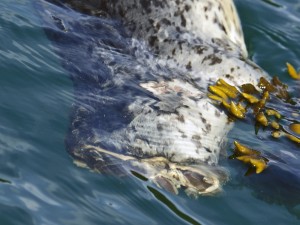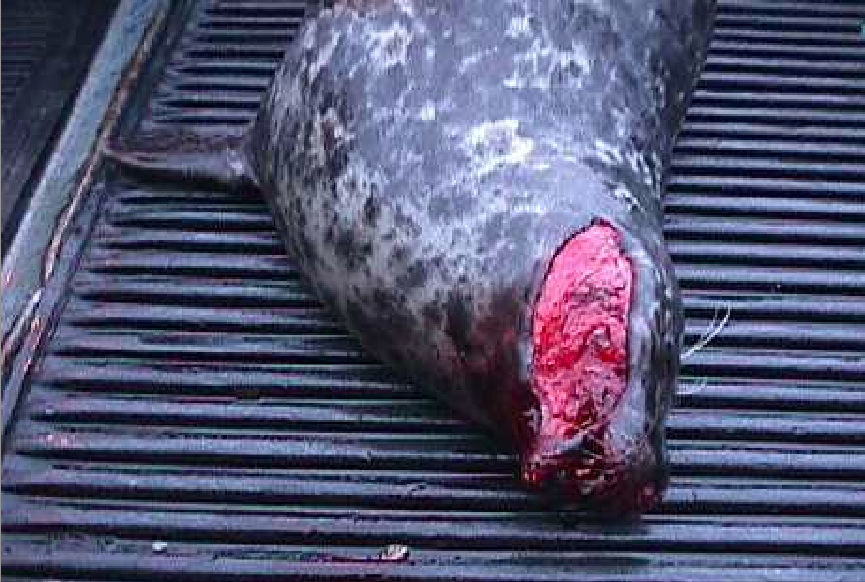 This dead harbour seal pup was the first of two found in a single week in Sept 2009 in the waters near Race Rocks. A boat traveling at great speed decapitated this animal and left another slice on the neck in the tell-tale pattern of propeller wounds.
This dead harbour seal pup was the first of two found in a single week in Sept 2009 in the waters near Race Rocks. A boat traveling at great speed decapitated this animal and left another slice on the neck in the tell-tale pattern of propeller wounds.
CASE STUDY: CONTROL OF SPEED OF BOATS
IN THE RACE ROCKS PILOT MARINE PROTECTED AREA
With the increase of marine ecotourism in the Southern part of Vancouver Island, the incidence of boats coming in contact with marine animals has become an issue. Commercial Whale-watching companies operating out of Victoria have contributed to a significant increase in boat traffic in the Race Rocks area, and although some respect the speed limits of the reserve, others have been slow to catch on. We recommend that boats proceed very slowly (no noticeable wake) and avoid coming too close to marine mammals or feeding and nesting marine birds. In the 1998 summer, at least three baby seals were struck and killed by boat motors. Baby Seals lie near the surface of the water and have no innate fear of rapidly moving boats. Adult seals and sea lions also occasionally get hit.
One example of a marine mammal collision is documented below from the Bamfield area. We present it here as a reminder to those in motor boats that speed must be controlled especially near marine mammal colonies. Our thanks to Sue Sanders and Nathan Webb of Bamfield Marine Station for the following information:
The seal in the picture was found by the driver of the School Boat, as he was dropping kids off on their way home, he was in the middle of Grappler Inlet, in Port Desire. (not sure if you are familiar with Bamfield- West side- Vancouver Island). This is a relatively sheltered area, but boats do go speeding through there. The driver contacted me at the station, as he thought perhaps I would be able to help the seal ( I am a small animal veterinarian as well as a PhD grad student). I went back to the site where the seal was with the driver, and using a large fish net we were able to get him out of the water and onto the boat. By the time we got to him he was barely able to maintain himself at the surface. Once in the boat he initially thrashed around a little, but then calmed down as soon as I placed my hands on him. As you can see from the picture, there was a large facial injury to the right side of his head, with a lot of musculature missing. Based on the amount of bleeding at the time of our recovery of the seal I would say he had lost a lot of blood, there was also frothy blood from his nostrils and mouth. I listened to his lungs and felt that there was significant fluid within the chest cavity also. Given the extreme nature of his injury and his poor condition I elected to euthanize him to alleviate further pain and suffering. In my opinion, I do not believe he could have survived even with major medical intervention, if such facilities had been available. I think this poor seal was on the verge of drowning, in addition to his severe injury, that appears to have been from a propeller. Good luck with your pilot study, emphasizing safe boating practices, and speed reduction is essential. I think people generally expect that marine animals will get out of the way of boats, but as we know this is not always the case.”

